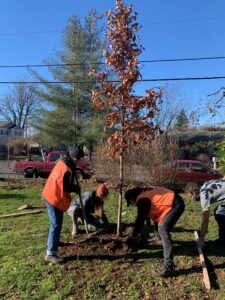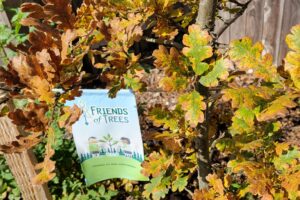Leaflet: Why We Love Oaks
We love oaks and you should too!
At Friends of Trees, we are particularly fond of oak trees, so much so that our mascot is Garry Oak. For our tree experts, it’s a go-to tree for reasons that go beyond its iconic nature.
“We got a lot of oaks this season,” says Neighborhood Trees Senior Specialist Drew Land. “As a species, they are an effective resource against climate change. And I want people to know that!”
A recent study published in Tree Physiology found that when mature oak trees were bathed in levels of CO2 equivalent to what is expected in 2050, the trees increased their rate of photosynthesis up to a third in response.

Some folks are reluctant to plant oak trees because they drop a lot of leaves. But we have learned that it’s healthier for your yard to leave the leaves, so that shouldn’t discourage you. Oak leaves are high in tannic acid and don’t decompose as immediately as other species, so they make for particularly good mulch.
Oak trees are particularly good providers to their ecological community, from contributing to the food web to managing the watershed to storing carbon. In those regards, it’s one of the most productive things you can put in your own yard.
“You plant an oak in your yard, you’re planting a zoo,” says Douglas W. Tallamy, author of The Nature of Oaks. “It’s your chance to create life that didn’t exist in that space.”
Oaks are the backbone of our local food chains and are crucial to feeding native insects, which feed the native and migratory birds and small mammals. The Willamette Valley was an Oregon White Oak savannah for 10,000 years. It doesn’t get any more native than that!
“Thankfully, we do plant loads of Oregon white oaks, which is the most important oak species locally,” Drew says. “But the more we plant, the better.”

